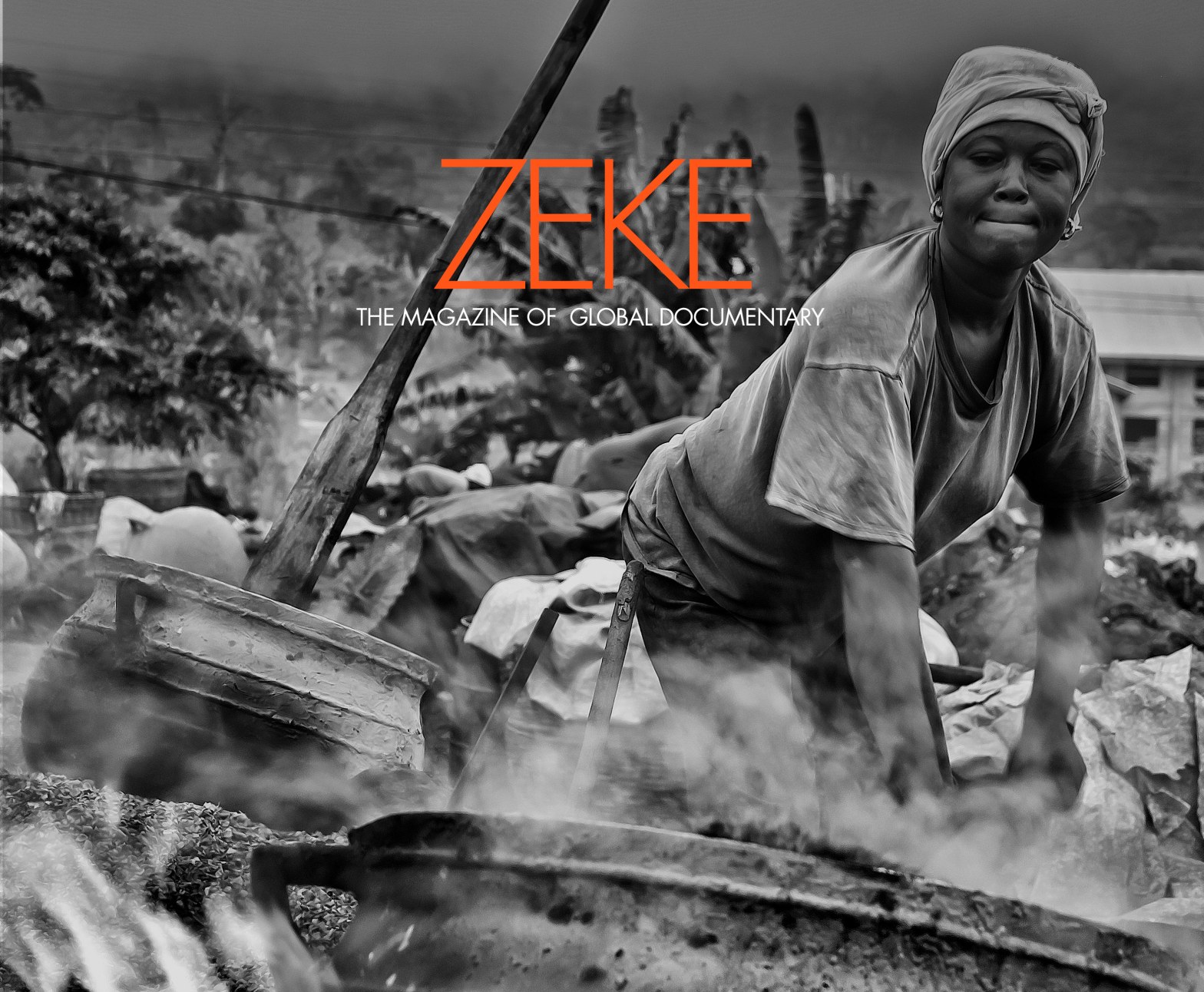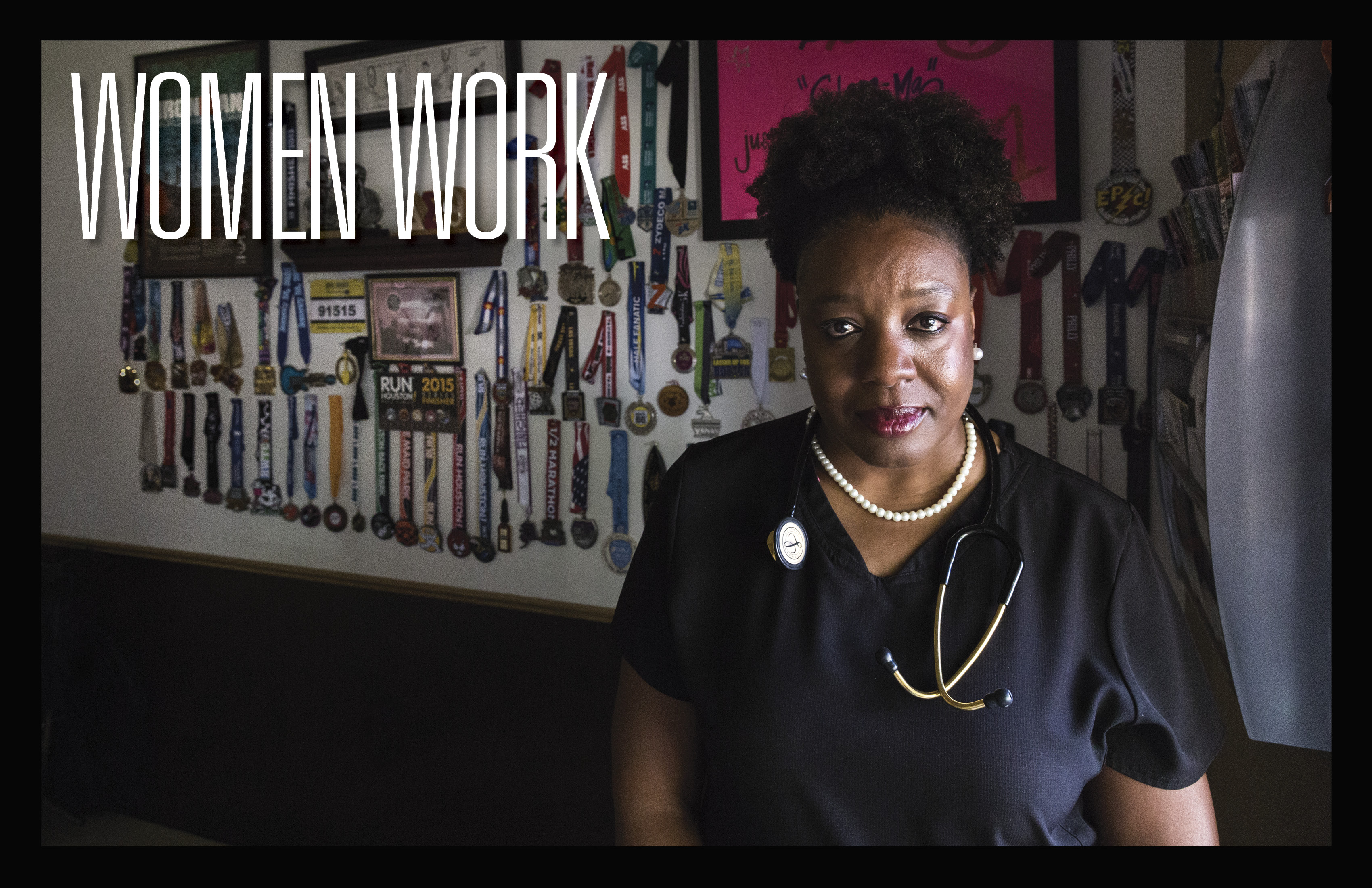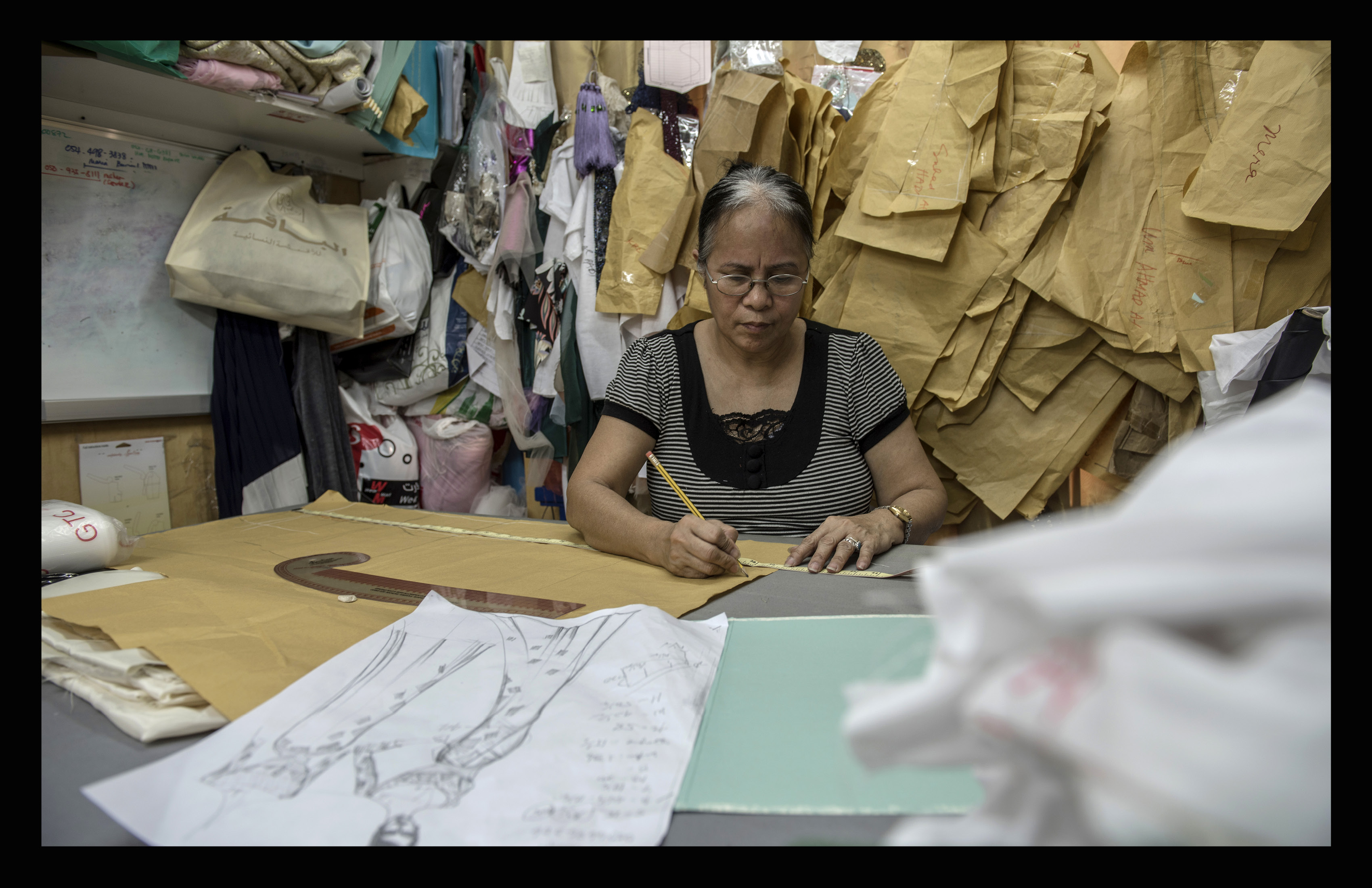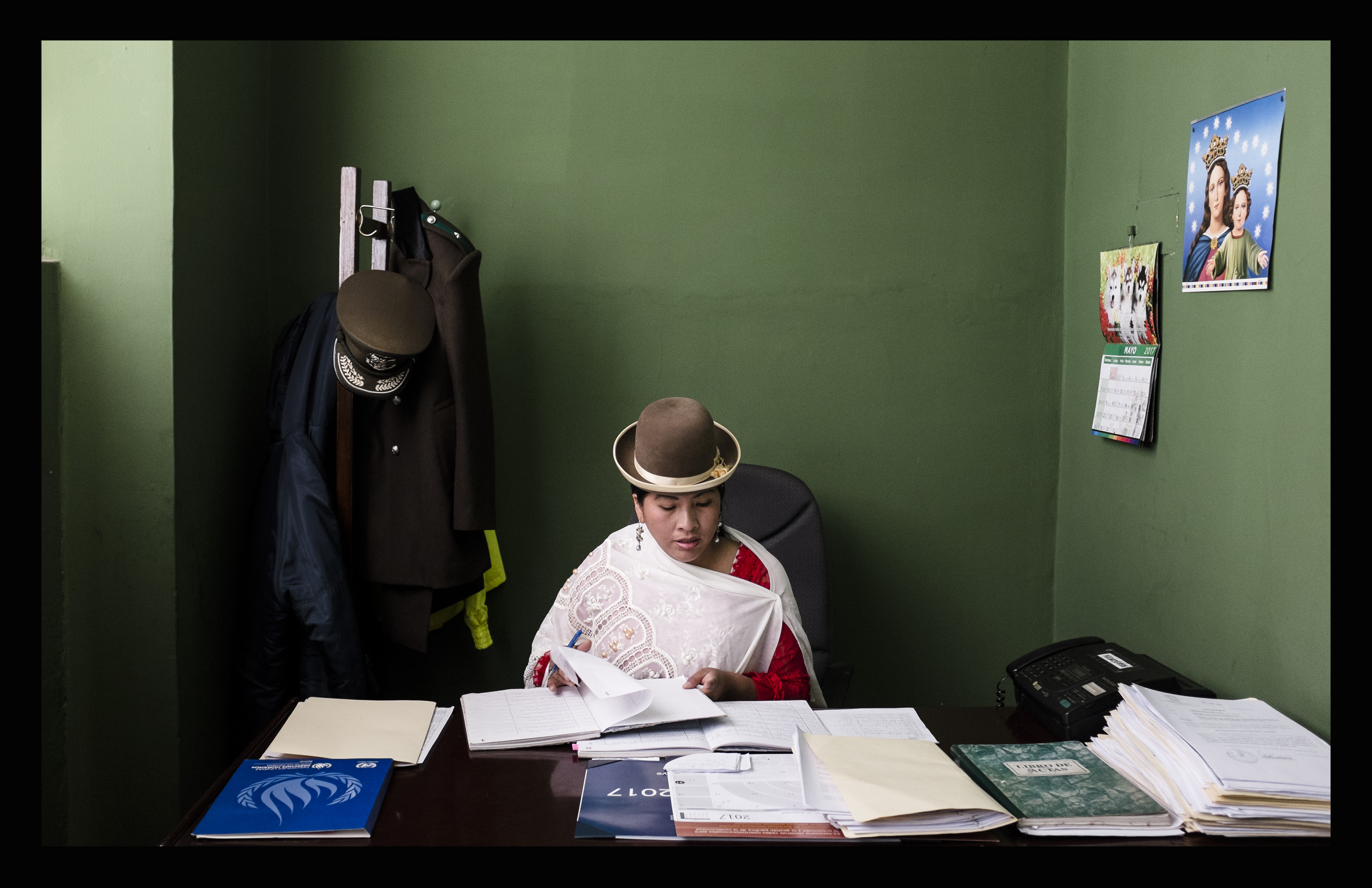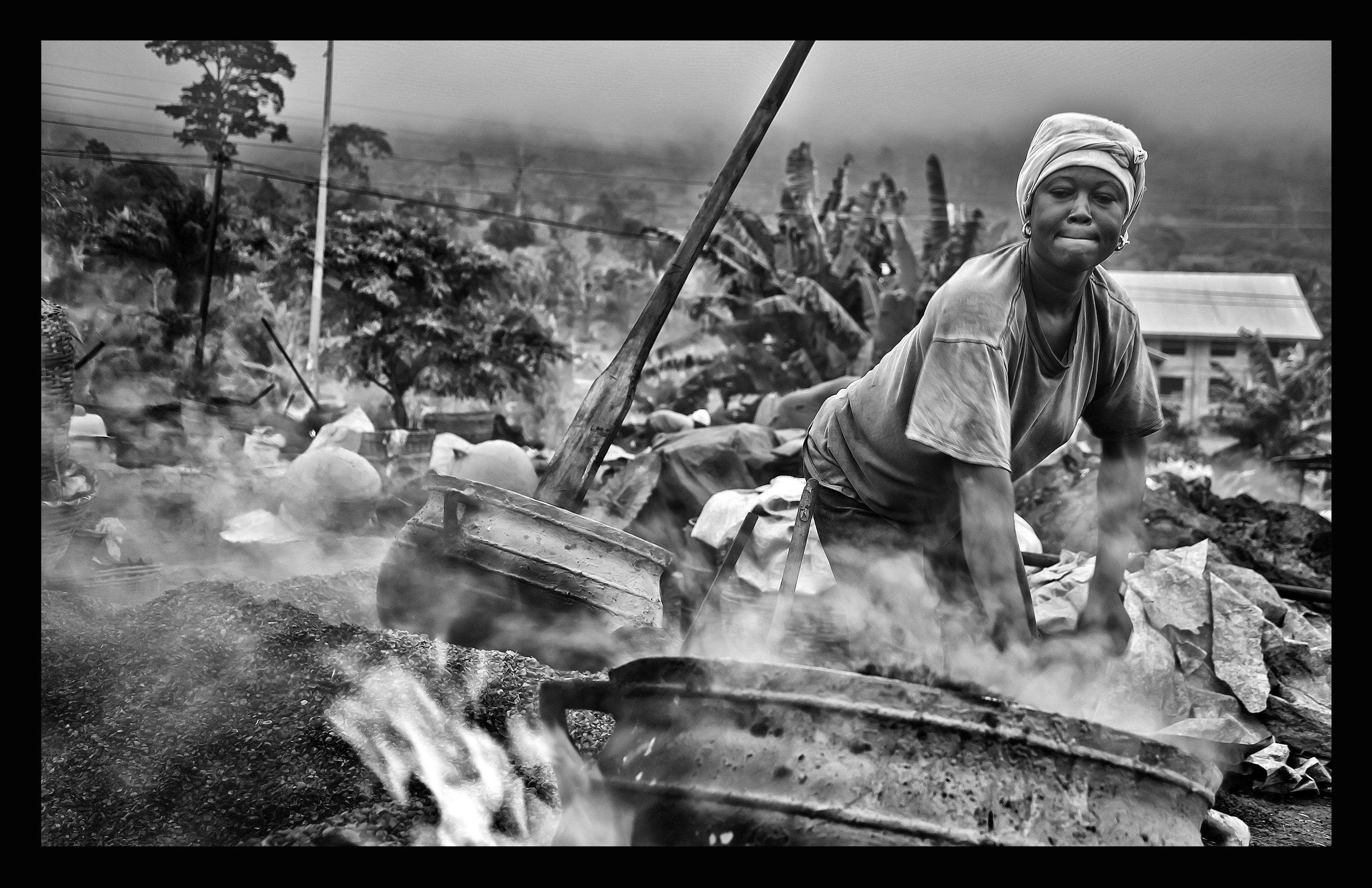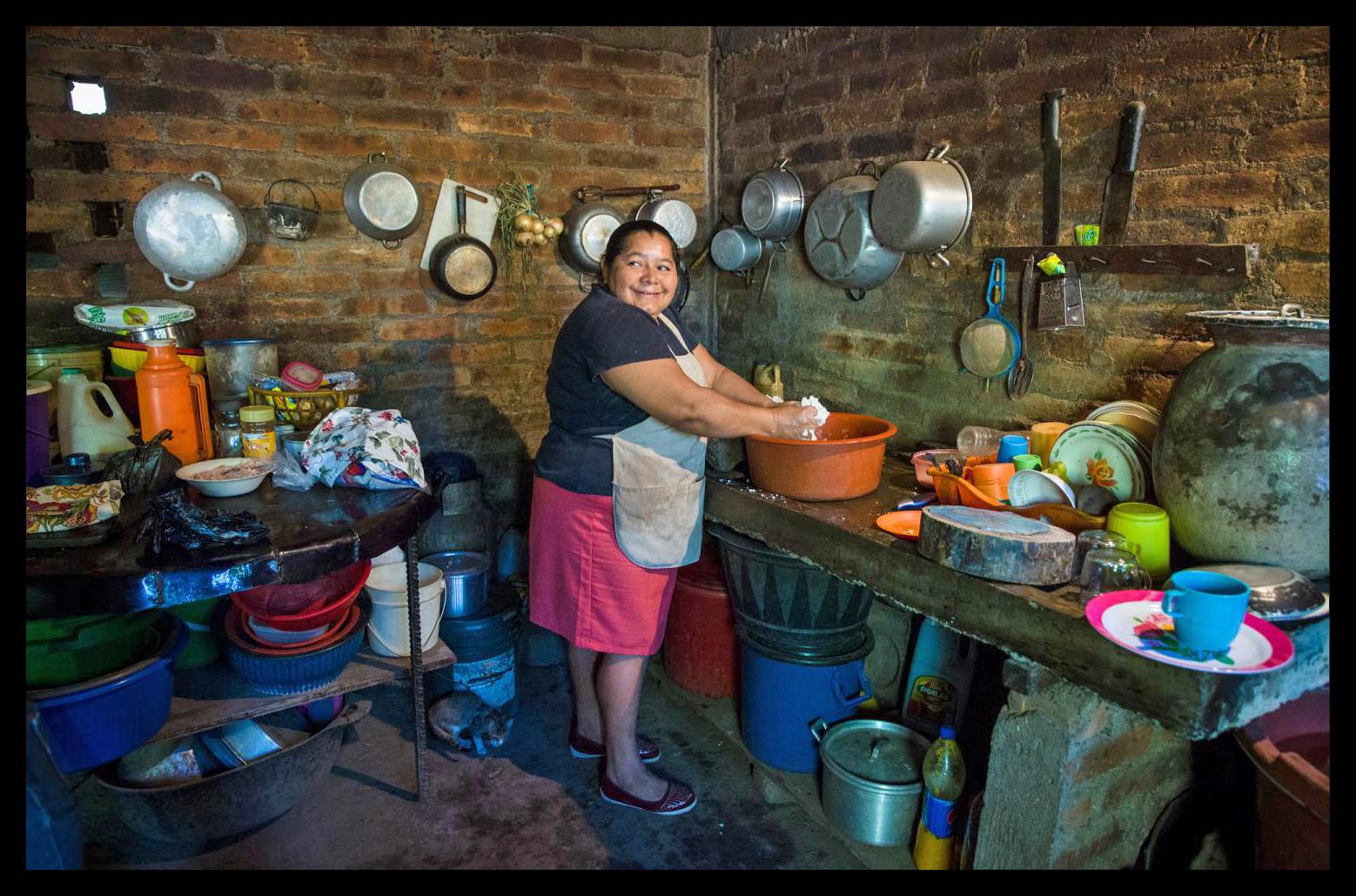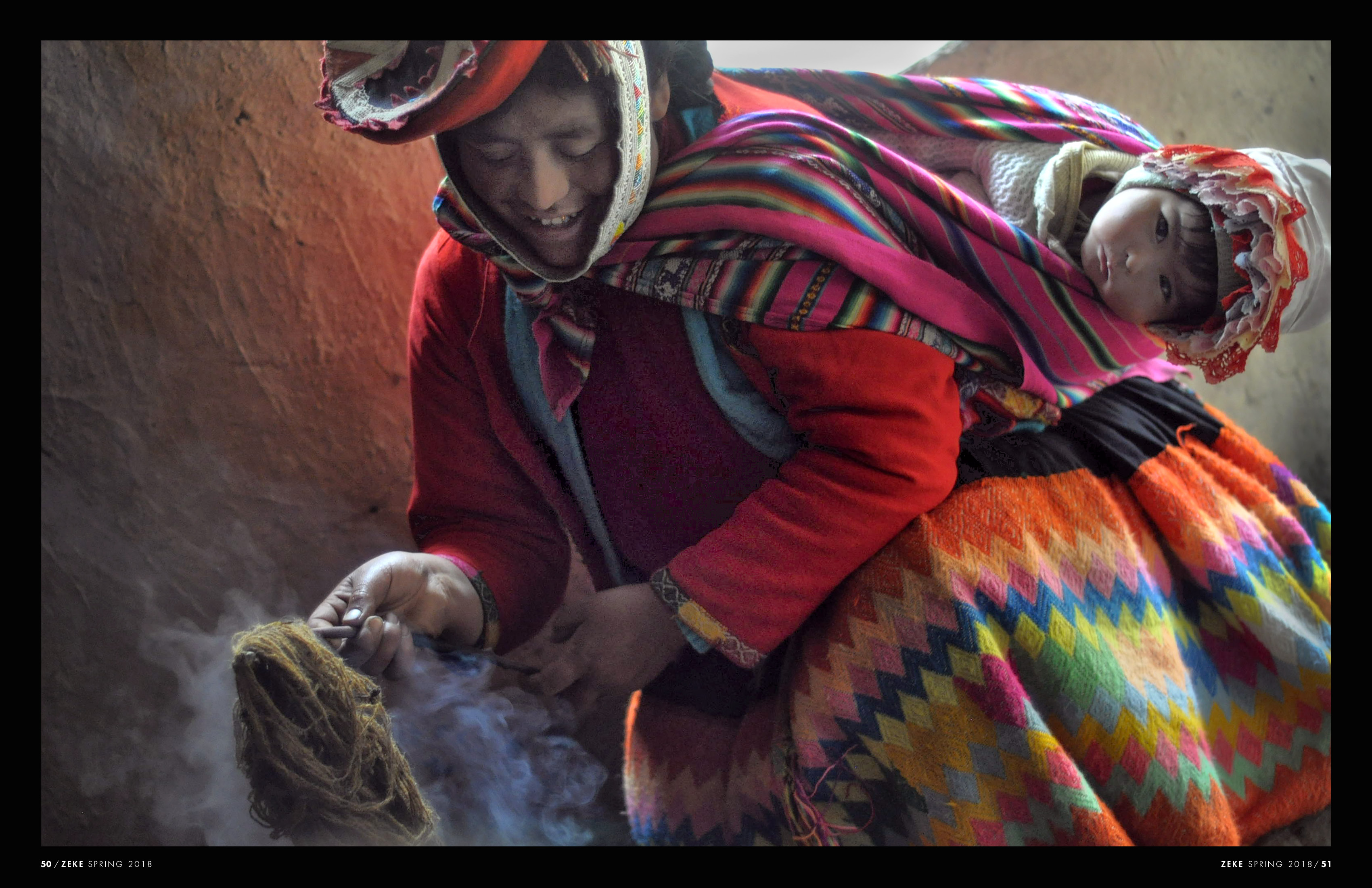Women Work: The Economic Power of Women
Photo Gallery
Photographs by Casey Atkins, Delphine Blast, Joan Lobis Brown, Vidhyaa Chandramohan, Susan Kessler, Valerie Leonard, Maranie Staab, and Beata Wolniewicz
According to UN Women, nowhere in the world has women’s participation in the labor force reached parity with men. While women are increasingly well-educated, labor markets still channel them disproportionately into work considered traditionally acceptable for women. Too few reach upper-level positions in management and leadership. According to the International Labor Office, women earn 77 percent of what men earn. These gaps are linked to the undervaluation of the work that women undertake and the need for women to take career breaks to attend to unpaid childcare and household family responsibilities.

Around the world, women are resilient, dedicated, and putting in a hard day’s work. Adrienne, in Joan Lobis Brown’s exhibit “Women of an UNcertain Age” worked 100 hours a week as a nurse practitioner to buy the equipment for her practice while she raised three kids. In “Women of the Congo: Farmers, Harvesters, Mothers,” photographer Maranie Staab highlights the strength and grace of Congolese female farmers. Despite their demanding activities, women who work the fields are still considered the inferior sex yet they continue to move ahead with quiet determination to positively impact their future.
In “Women’s Worth” by Casey Atkins, Nicaraguan women challenge the male-dominated economy by owning their own businesses. Women thrive through food production, an industry which allows for flexible hours and the ability to work from home. This convenience of home-based ventures gives low-income women the opportunity to provide for their families.
Photojournalist Beata Wolniewicz, in her exhibit, “Tough Life, Strong Women,” captures the labor of women in Ghana, subject to difficult and often times dangerous conditions in the production of cocoa oil. Despite challenges these women find joy and gracefully accept their responsibilities.
In “Peruvian Weavers,” Susan Kessler documents women weavers in the Andes Mountains of Peru who support themselves financially while retaining their traditional way of life.
For a dollar a day, women break coal from the mines in the State of Jharkhand, in northeast India. Valerie Leonard’s exhibit “Black Hell” depicts the toxic environment as women sacrifice their lives for economic development. Around the world, women are migrating to seek work and better lives. In “Transnational Mothers,” Vidhyaa Chandramohan captures the challenges migrant workers encounter while working in a foreign land, far from their children.
—Ezinne Ukoha

The Economic Power of Women
by Ezinne Ukoha with contributions by Wendy McDowell

With advancements in technology, female entrepreneurs are discovering new opportunities to be competitive with their male counterparts in the international arena.
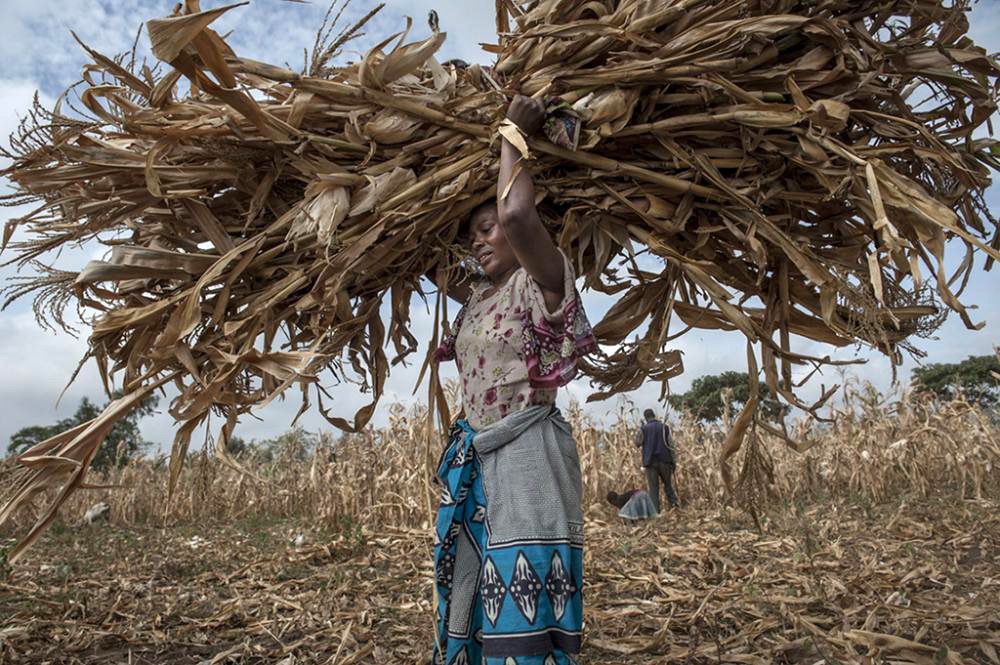
Many of the world’s women hold dual roles as workers and as mothers/caregivers, but their important contributions to the global economy are downplayed and undervalued. Though women contribute to the economic viability of their families, communities, and nations, the stereotype persists that “breadwinner” men are more valuable members of the workforce. In addition to their paid work, women throughout the world engage in a remarkable range of unpaid housework and care work each day. This includes fetching water, preparing food, and caring for the young, old, sick, and disabled.

When paid and unpaid work are combined, women work more than men the world over. This disparity is particularly stark in developing countries. According to an International Labour Organization (ILO) report Women at Work: Trends 2016, other important factors that underscore the inequities at work include: a higher share of women in part-time employment, and more women than men underemployed against their wishes.
Women are also more likely than men to work in the care economy, in jobs that are too often underpaid, unregulated, and do not offer worker benefits. The ILO estimates that over 100 million workers survive through the care economy, over 90 percent of whom are women and migrants. Migrant women are the most vulnerable, often subject to long hours, low pay, and unregulated working conditions, without access to benefits or legal protections that might mitigate these harsh realities. Migrants often remain dependent on their employers for basic amenities, living arrangements, and to shield them from deportation.

Women are essential to agricultural production, especially in the developing world, but this work also tends to be informal, unpaid, and invisible. A report from Global Volunteers notes that “women comprise 43 percent of the world’s agricultural labor force—rising to 70 percent in some countries.” UN WomenWatch points out that “Rural women play a key role in supporting their households and communities in achieving food and nutrition security, generating income, and improving rural livelihoods and overall well-being.” Yet this report also notes that “globally, and with only a few exceptions, rural women fare worse than rural men and urban women and men for every Millennium Development Goal indicator for which data are available.” This is due to lower education and literacy rates among rural women, a lack of services and infrastructure, and their underrepresentation in politics and decision-making groups.
Progress Made but More Needed
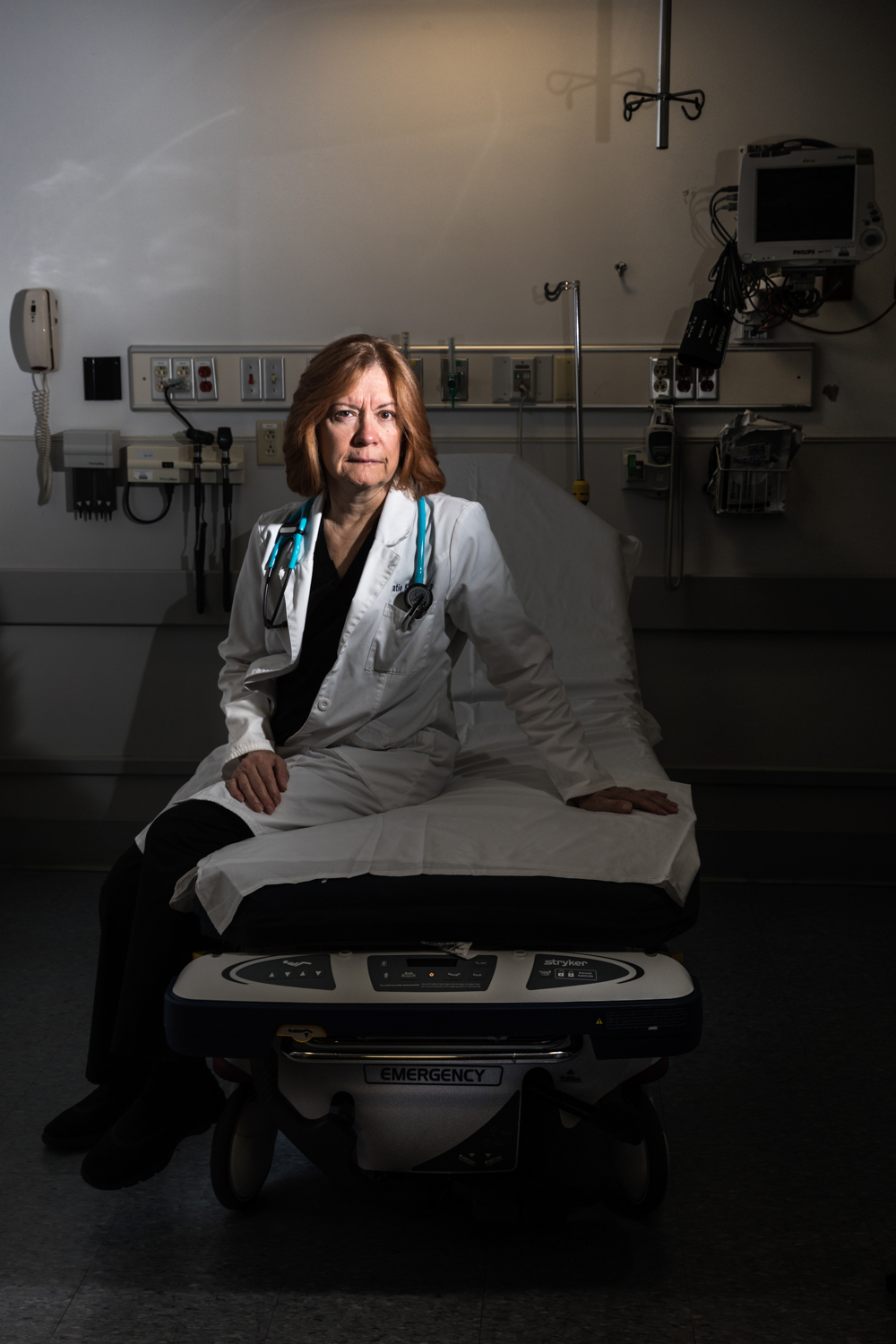
There has been some progress during the last 20 years. The number of women engaged in informal work has decreased (down by 17 percent); the amount of time women spend on unpaid work has narrowed (mostly due to a reduction in time spent on housework); and the number of women engaged in entrepreneurial enterprises has increased. A 2016/2017 Women’s Entrepreneurship Report from the Global Entrepreneurship Monitor (GEM) estimates that “163 million women are activating new businesses while about 11 million are responsible for the operations of already established ventures,” and notes a 10% increase in overall female TEA (total entrepreneurial activity) in the past two years.
With advancements in technology, female entrepreneurs are discovering new opportunities to be competitive with their male counterparts in the international arena. However, in parts of the world crippled by underdevelopment, women still do not have the tools and technological capacity to compete. Other systemic problems stymie women business owners, including a lack of supportive civic organizations and commercial lending systems that tend to be biased against women.
Even if female entrepreneurs were to be fully supported, this would not improve the lives of most women at work given widespread “occupation segregation”—in the US, for example, four out of ten women work in lower paying occupations where at least 75% of the workers are female. According to a 2015 poll of more than 9,500 women in the G20 countries, “work-family balance” was the top work-related issue for women (equal pay and harassment came in as the second and third respectively).
Legislation Needed to End Inequality
Governments need to tackle these issues of inequity head on by developing national women’s economic development strategies that help level the playing field and empower women workers. At the least, policies must be enacted to provide protection and recourse for exploited workers, requiring employers to engage in wage transparency, provide adequate job training, and institute nondiscriminatory job reviews. The ILO concludes that work-family policies are the most important ingredient; they are “the missing link to more and quality jobs for women.” Thus, the ILO calls for the adoption of international labor standards “promoting non-discrimination, equal remuneration for work of equal value, social protection, maternity protection and support to workers with family responsibilities.”
To facilitate these changes, already established women’s trade organizations and unions need to be supported and new ones need to be formed. One example is the Self-Employed Women’s Association (SEWA) in India, a trade union which makes visible the typically invisible work of poor, self-employed women (94% of working women in India work in the “unorganized sector”). There are also effective NGO programs and partnerships that can be expanded and replicated, such as “Better Work,” a joint project of the ILO and the International Finance Corporation (IFC) to increase gender equality in the garment industry. Appointing more women to key economic positions is important, as well. Ngozi Okonjo-Iweala, a Nigerian economist and the first female minister of finance in the region, was responsible for initiating programs to help women and children such as the Growing Girls and Women in Nigeria Programme (GWIN) and the Youth Innovation program (YouWin).
If work opportunities and conditions improve for women, it is not only women who will benefit. Each country, and the entire global economy, will see growth. A 2016 McKinsey Global Institute study calculated there would be a whopping $12 trillion added to the global annual GDP in a “best in region” scenario “in which all countries match the rate of improvement of the fastest-improving country in their region.” In a “full potential” scenario in which women play an identical role in labor markets to that of men, the study concludes “as much as $28 trillion, or 26 percent, could be added to global annual GDP by 2025.”
Hopefully the challenges women face as workers will be recognized and wide-ranging solutions will be found. When women are championed, they contribute, create, innovate, and become forces of economic sustenance and power for their families, communities, and the world.
Contributors and Resources
Photographers
Casey Atkins currently works in the Boston area as a freelance photographer and filmmaker. She is a member of both the Boston Press Photographers Association and the National Press Photographers Association, as well on the board for the New England chapter of the American Society of Media Photographers.She is also a director of Women’s Worth, Inc., a nonprofit which provides business skills training to low-income women in Nicaragua.
Delphine Blast is a French documentary and portrait photographer, based in Bolivia. She works on various issues related to development with a strong focus on women’s issues in South America.
Amber Bracken is a member of Rogue Collective and a lifelong Albertan. Her interest is in the intersection of photography, journalism, and public service with a special focus on First Nations People.
Joan Lobis Brown is a photographer whose portrait projects highlight segments of our society that have been subjected to intense stigma.
Vidhyaa Chandramohan is an editorial & documentary photographer from India, currently based in Abu Dhabi. Her long-term projects delve into women-related projects/issues, human rights and gender identity.
Jean Chung is an award-winning photojournalist based in Seoul, South Korea who gained international recognition with her series of photo-reportage in Afghanistan and Africa.
Anica James is a documentary photographer and photography instructor currently based in Peterborough, Ontario, Canada. She is a member of Muse Projects and Women Photograph.
Susan Kessler is a practicing architect turned documentary photographer who is most passionate about photographing for organizations that positively impact the lives of women and children in developing countries.
Heba Khamis is an Egyptian storyteller whose work concentrates on social issues that are often ignored.
Valerie Leonard travels the world following her theme, “Labours of Hercules,” a series of photographs that attempts to show with utmost respect the dignity of women and men living and working in hostile environments.
Amy Martin uses her camera’s lens to increase awareness, understanding and compassion across physical and social barriers.
Marinka Masséus’s photography revolves around people and is a constant reflection of her passion and fascination for human nature and the way we live our lives. Topics concerning injustice and gender inequality are a driving force behind her work.
Emily Schiffer is a photographer and mixed media artist interested in the intersection between art, community engagement, and social change.
Maranie Rae Staab is a Pittsburgh-based, independent photographer and journalist working to document human rights and social justice issues, displacement and how violence and war affect individuals and societies.
Danielle Villasana is an independent photojournalist whose documentary work focuses on women, identity, human rights, and health. She is currently based in Istanbul and contributes to Redux.
Beata Wolniewicz is a Polish photojournalist and documentary photographer, who has travelled to many countries including Georgia, Ghana, Israel, Lebanon, USA, Poland and many European countries.
Diana Zeyneb Alhindawi was born in Romania to a Romanian mother and Iraqi father. She uses photography to explore the human condition across various political and cultural contexts. She is based in Brooklyn, NY but often works in areas experiencing social unrest or humanitarian emergencies.
Writers
Immaculata Abba is a writer and photographer studying History and Comparative Literature at Queen Mary University of London.
Danielle Avram is a writer, photographer, and curator based in Dallas, Texas.
Wendy McDowell is a writer and editor living in Cambridge, Massachusetts and the Senior Editor of the Harvard Divinity Bulletin.
Jenna Mulhall-Brereton is both a photographer and a professional in the philanthropy sector—two passions that are fueled by her travels throughout the world.
Alison Nordström is an independent writer and curator based in Cambridge, Massachusetts specializing in historical and contemporary photographs of all kinds. Formerly the Director and Senior Curator of the Southeast Museum of Photography, (Florida)and Senior Curator of Photographs at George Eastman House, (New York) she is the author of over 100 published books and essays on photographic topics, and has curated over 150 photographic exhibitions in nine countries.
Ladan Osman was born in Somalia, her chapbook, Ordinary Heaven, appears in Seven New Generation African Poets. She is a contributing editor of The Offing and lives in Chicago.
Anne Sahler is an internationally published writer, photographer and graphic designer who divides her time between Japan and her homeland of Germany. Her curious nature and never-ending need for travel help lend a clarity of perspective to an evermore complicated world.
Nayo Sasaki-Picou is a New York-based interdisciplinary artist and recent graduate of New York University’s Master of Arts program. Her latest written and photographic work is featured on SDN and titled Afrobeat: The Way She Moves.
J. Sybylla Smith is an independent curator with more than 25 solo or group exhibitions featuring over 80 international photographers exhibited in the US, Mexico and South America. An adjunct professor, guest lecturer and thesis advisor, Sybylla has worked with the School of Visual Arts, the School of the Museum of Fine Arts, Wellesley College, and Harvard University. She is also the guest editor of the Women’s Issue of ZEKE magazine.
Erin Thompson studies the damage done to humanity’s shared heritage through looting, theft, and the deliberate destruction of art. She co-curated “Ode to the Sea: Art from Guantánamo,” the first full-scale exhibit of art created by detainees at Guantánamo Bay Detention Camp, displayed at John Jay College of Criminal Justice.
Ezinne Ukoha is a multimedia journalist and the founding editor of MyTrendyBuzz, a pop culture and entertainment-themed website. She was raised in Lagos, Nigeria and recently recognized as one of Medium’s Noteworthy writers.
Resources
Women PhotographWomen Photograph is an initiative that launched in 2017 to elevate the voices of female visual journalists. The private database includes more than 700 independent women documentary photographers based in 91 countries and is available to any commissioning editor or organization.
Women Photojournalists of WashingtonWomen Photojournalists of Washington is a nonprofit dedicated to educating the public about the role of women in photojournalism and fostering their professional success. With over 250 members across the visual journalism field, WPOW creates a strong community of women photojournalists who gather to inspire and educate.
Women’s Photo AllianceFacebook GroupInstagramThe Women’s Photo Alliance (WPA) was founded in 2015 to promote and support women photographers in order to diversify a male-dominated field. The group’s mission is to offer multiple perspectives, challenge stereotypes, and make the point of view of women more universal.
Native FoundationWhile the journalism and documentary industry struggle with issues of diversity and representation, Native wants to change visual journalism to be representative of diverse talent from across the globe. We connect emerging journalists, documentary makers and visual storytellers from underrepresented regions and communities with major publications and introduce them to a global audience.
Alliance for Women in Media The Alliance for Women in Media is an organization for women, by women. We are committed to supporting women across all media segments, to expand networks, educate and celebrate accomplishments.

Masthead

ZEKE is published by Social Documentary Network (SDN), an organization promoting visual storytelling about global themes. Started as a website in 2008, today SDN works with thousands of photographers around the world to tell important stories through the visual medium of photography and multimedia. Since 2008, SDN has featured more than 2,800 exhibits on its website and has had gallery exhibitions in major cities around the world. All the work featured in ZEKE first appeared on the SDN website, www.socialdocumentary.net.
Spring 2018 Vol. 4/No. 1
ZEKE
Executive Editor: Glenn Ruga Guest Editor: J. Sybylla SmithEditor: Barbara Ayotte
Social Documentary Network
Founder & Director: Glenn RugaCommunications Director: Barbara AyotteSpecial Issue Editor: Caterina ClericiIntern: Demi Yueying Du
SDN Advisory Committee
Lori Grinker, New York, NYIndependent Photographer and Educator
Catherine Karnow, San Francisco, CAIndependent Photographer and Educator
Ed Kashi, Montclair, NJMember of VII photo agencyPhotographer, Filmmaker, Educator
Reza, Paris, FrancePhotographer and Humanist
Molly Roberts, Washington, DCSenior Photography Editor, National Geographic
Jeffrey D. Smith, New York NYDirector, Contact Press Images
Jamey Stillings, Sante Fe, NMIndependent Photographer
Steve Walker, Danbury, CTConsultant and Educator
Frank Ward, Williamsburg, MAPhotographer and Educator
Amy Yenkin, New York, NYIndependent Producer and Editor
ZEKE is published twice a year by Social Documentary Network Copyright © 2018 Social Documentary Network Print ISSN 2381-1390
ZEKE does not accept unsolicited submissions. To be considered for publication in ZEKE, submit your work to the SDN website either as a standard exhibit or a submission to a Call for Entries. Contributing photographers can choose to pay a fee for their work to be exhibited on SDN for a year or they can choose a free trial. Free trials have the same opportunity to be published in ZEKE as paid exhibits.
To subscribe: www.zekemagazine.com/subscribe
Advertising inquiries: glenn@socialdocumentary.net
Donors to The Campaign for ZEKE
ZEKE magazine and SDN would like to thank the following donors to The Campaign for ZEKE. Their support allows ZEKE to continue publishing. If you would like to support ZEKE, please visit www.zekemagazine.com/campaignforzeke
Founding SponsorRoree Iris Williams
BenefactorRudi DundasMartha Kongsgaard and Peter GoldmanJamey Stillings Photography, Inc.
SustainerAnonymous DonorJudy and Bob AyotteSusan Mazer
SupporterAnonymous Donors (1)Carol Allen-StoreyDr. and Mrs. Julien P. AyotteConnie Frisbee HoudeRobert I. Usdan and Amy YenkinJan Zychlinski
ContributorAnonymous Donors (4)Farida AlamDawn ColsiaMargo CooperMorrie GasserVivien GoldmanJohn ParisiPedro PerezJamie RoseBruce RosenCarolina SandrettoBob and Janet Walerstein Winston
DonorAnonymous Donors (7)Michelle BogreLiane BrandonCarla FiorinaJennifer FishNancy FultonJanet HunkelMichael KaneRusty LeffelHelena LongEric LudenPatrick McCarthyNathaniel NovodAlice NudelmanTracy PriceJames PyrzynskiMark TuschmanBenita VanWinkleAndrea Zocchi

Social Documentary Network61 Potter Street Concord, MA 01742 USA 617-417-5981 info@socialdocumentary.net www.socialdocumentary.net www.zekemagazine.com Twitter: @socdoctweetsInstagram: @socialdocumentarynetSDN FacebookZEKE Facebook
